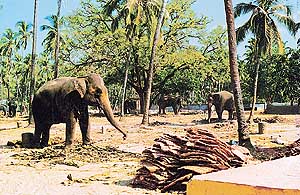 |
 |
In the land of
elephants IT is interesting to consider, as to how, the elephants — the Elephant God’s well loved representatives, are faring in India since September is Ganesh Chaturthi. The view is not encouraging. With elephants carrying a divine halo, they live longer than their African cousins who occupy a low position, as just one denizen of the forest to lure tourists. Some recent surveys have borne this out that the Asian pachyderms (estimated at 35000 in number), which includes the Royal White elephant of Thailand, will outlast their African counterparts. The number of elephants in India is "guessed to be about 18000" a considerable reduction in the last 50 years. But in the southern most state of Kerala, we have the maximum number of domesticated elephants — about 550 — and here is situated the largest elephant farm, attached to the famous temple of Guruvayoor in north Kerala. Three kilometres away from the temple, this farm with its 41 elephants (33 male and 8 female) is situated in the centuries old coconut farm of the former Rajahs of Punnathur, the ancient palace providing administrative offices for the farm. |
|||||||||
 Want to hire an elephant for a religious
festival? Or, as a ride for a VIP family bridegroom? Well, you can rent
one, if you are in Kerala, where the Guruvayoor temple this auspicious
symbol of "obstacle remover" ..It cost just Rs 800. Many
ancient temples with elephants have lost their vast acres of temple
property to the ‘land to the tiller’ movement. And quite a number of
smaller temples have ‘Elephants’ gifted to them, which they cannot
maintain. The Guruvayoor temple elephant farms takes these elephants and
brings them up. Ranging from baby elephants that are only a few weeks
old to grandmotherly pachyderms, the elephants are trained to obey
commands and participate in the temple rituals. They learn to move
the trunk to the left or right as commanded, kneel down to enable the
deity to be placed on the back and trumpet a hearty welcome to the
deity. Want to hire an elephant for a religious
festival? Or, as a ride for a VIP family bridegroom? Well, you can rent
one, if you are in Kerala, where the Guruvayoor temple this auspicious
symbol of "obstacle remover" ..It cost just Rs 800. Many
ancient temples with elephants have lost their vast acres of temple
property to the ‘land to the tiller’ movement. And quite a number of
smaller temples have ‘Elephants’ gifted to them, which they cannot
maintain. The Guruvayoor temple elephant farms takes these elephants and
brings them up. Ranging from baby elephants that are only a few weeks
old to grandmotherly pachyderms, the elephants are trained to obey
commands and participate in the temple rituals. They learn to move
the trunk to the left or right as commanded, kneel down to enable the
deity to be placed on the back and trumpet a hearty welcome to the
deity.
The farm employees 98 mahouts, , on the basis of three mahouts for the large elephants and two each for the smaller ones. There is a supervisor to take care of administrative matters and a whole time veterinary doctor available to take care of elephantine health problems. It was not possible to find out as to how much it was costing the temple to run this nine-acre farm with nearly four dozen elephants. But a ‘local’ elephant enthusiast added up the costs and opined that it must be between Rs 3 to 5 million every year, a portion of the amount being recovered by the ‘hiring out’ charges.
It is said that the elephant race dates from the 18th century. In those days, the Guruvayoor temple was under the management of another famous temple nearby, the Trikkannamatilakam temple. Elephants for the annual ceremonial flag hoisting of the Guruvayoor temple, a ritual that marked the start of the festival, used to come from the Trikkannamatilakam temple on ‘loan’. One year, in the 18th century, owing to some misunderstanding’, the elephants were not sent for the function. But surprisingly, as the auspicious hour for the ceremonial flag hoisting approached, the elephants from the stables of the Trikkannamatilakam temple broke their tied chains and rushed to the Guruvayoor temple, arriving just in time for the ritual to commence. In honour of this divine intervention, this miraculous run’ of the elephants to the Guruvayoor temple is commemorated in the annual elephant race. The elephants, as befitting a group of very intelligent animals, are keenly conscious of the honour of winning the race. The enthusiasm of the mahouts gets reflected in their behaviour. A few years ago, the winner and the runners-up (the elephants Ramankutty and Ravindran) began to fight inside the temple. With seven more elephants in the temple corridor, the worshippers began to panic and in the ensuring melee one spectator died and fifteen others were injured. Since then the race is run with more restrictions and precautions. It is befitting that with such a grand tradition of elephant lore, India’s largest elephant farm is maintained by Guruvayoor temple. — MF |